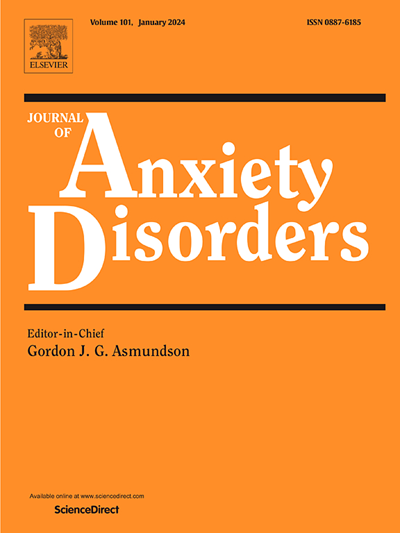创伤后应激障碍和慢性疼痛状况的纵向病程:一项对加拿大军事人员超过16年的基于人群的研究
IF 4.5
2区 医学
Q1 PSYCHIATRY
引用次数: 0
摘要
背景:创伤后应激障碍(PTSD)和慢性疼痛是军队中非常普遍、合并症和衰弱性疾病。本研究旨在研究慢性疼痛状况(如偏头痛、背部问题、关节炎)在创伤后应激障碍病程(即无创伤后应激障碍、缓解、新发、持续/复发)中的患病率,并研究PTSD病程与慢性疼痛状况的存在和发作之间的关系。方法:对2002年加拿大社区卫生调查《加拿大军人心理健康与福祉补编》和2018年加拿大武装部队成员和退伍军人心理健康随访调查的数据(n = 2941)进行交叉表列和logistic回归分析。结果:创伤后应激障碍病程中慢性疼痛的患病率从8% %到61% %不等,无创伤后应激障碍的患病率始终最低。协变量调整后,受访者与新出现创伤后应激障碍的几率升高背部问题(优势比= 1.43,95 % CI [1.10 - -1.90], p & lt; . 05),关节炎(优势比= 1.46,95 % CI [1.06 - -2.00], p & lt; . 05),和一个新的出现慢性疼痛条件更广泛(优势比= 1.66,95 % CI [1.15 - -2.39], p & lt; . 01),而那些没有创伤后应激障碍。与无PTSD患者相比,PTSD缓解者偏头痛发生率更高(AOR=2.43, 95 % CI [1.29-4.58], p <; .01),而持续性PTSD患者背部问题发生率更低(AOR=0.45, 95 % CI [0.23-0.88], p <; .05)。结论:研究结果表明,加拿大军人PTSD并发慢性疼痛的患病率和类型随PTSD病程的变化而变化。这强调了评估创伤后应激障碍患者疼痛的重要性,并表明创伤后应激障碍的病程是病例概念化和治疗计划的相关考虑因素。本文章由计算机程序翻译,如有差异,请以英文原文为准。
Longitudinal course of posttraumatic stress disorder and chronic pain conditions: A population-based study of Canadian military personnel over 16 years
Background
Posttraumatic stress disorder (PTSD) and chronic pain are highly prevalent, comorbid, and debilitating conditions in the military. The present study was designed to examine the prevalence of chronic pain conditions (i.e., migraines, back problems, arthritis) across PTSD courses (i.e., no PTSD, remitted, new onset, persistent/recurrent) and examine the association between PTSD course and the presence and onset of chronic pain conditions in a population-representative sample of Canadian military members. Methods: Cross-tabulations and logistic regressions were conducted on data (n = 2941) from the 2002 Canadian Community Health Survey Mental Health and Well-being Canadian Forces Supplement and the 2018 Canadian Armed Forces Members and Veterans Mental Health Follow-Up Survey. Results: The prevalence of chronic pain conditions across PTSD courses ranged from 8 % to 61 %, with no PTSD consistently having the lowest prevalence. After adjusting for covariates, respondents with new onset PTSD had elevated odds of back problems (AOR=1.43, 95 % CI [1.10–1.90], p < .05), arthritis (AOR=1.46, 95 % CI [1.06–2.00], p < .05), and a new onset chronic pain condition more broadly (AOR=1.66, 95 % CI [1.15–2.39], p < .01), compared to those with no PTSD. Those with remitted PTSD had greater odds of migraines (AOR=2.43, 95 % CI [1.29–4.58], p < .01), while those with persistent PTSD had lower odds of back problems (AOR=0.45, 95 % CI [0.23–0.88], p < .05), compared to those with no PTSD. Conclusion: Findings indicate that the prevalence and type of chronic pain that co-occurs with PSTD in Canadian military members varies as a function of the course of PTSD. This underscores the importance of evaluating pain in those with PTSD and suggests that the course of PTSD is a relevant consideration in case conceptualization and treatment planning.
求助全文
通过发布文献求助,成功后即可免费获取论文全文。
去求助
来源期刊

Journal of Anxiety Disorders
Multiple-
CiteScore
16.60
自引率
2.90%
发文量
95
期刊介绍:
The Journal of Anxiety Disorders is an interdisciplinary journal that publishes research papers on all aspects of anxiety disorders for individuals of all age groups, including children, adolescents, adults, and the elderly. Manuscripts that focus on disorders previously classified as anxiety disorders such as obsessive-compulsive disorder and posttraumatic stress disorder, as well as the new category of illness anxiety disorder, are also within the scope of the journal. The research areas of focus include traditional, behavioral, cognitive, and biological assessment; diagnosis and classification; psychosocial and psychopharmacological treatment; genetics; epidemiology; and prevention. The journal welcomes theoretical and review articles that significantly contribute to current knowledge in the field. It is abstracted and indexed in various databases such as Elsevier, BIOBASE, PubMed/Medline, PsycINFO, BIOSIS Citation Index, BRS Data, Current Contents - Social & Behavioral Sciences, Pascal Francis, Scopus, and Google Scholar.
 求助内容:
求助内容: 应助结果提醒方式:
应助结果提醒方式:


